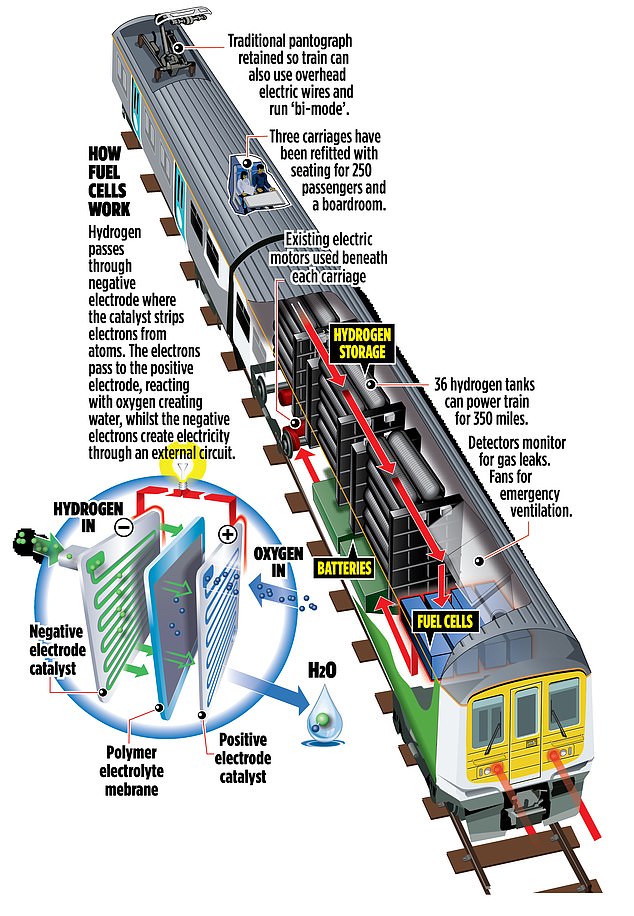Two centuries after the UK led the world by opening the first passenger railway between Stockton and Darlington, I’m chugging through the Warwickshire countryside on a short train journey that could prove just as revolutionary.
I have been invited to be the first reporter to take a ride on Britain’s first hydrogen-powered train.
The train – top speed 90mph – has passed stringent safety checks and clocked up 3,000 miles of test runs on main lines.
Called HydroFLEX, the concept is now ready to be incorporated in a new fleet. It could replace diesel trains on lines that are too costly to electrify and where batteries would not be viable.
The prototype could herald a new age of environmentally-friendly transport on Britain’s railways and boost the nation’s ambitions of being a green industrial powerhouse.
I was given a tour of the hydrogen train at Long Marston depot in Warwickshire before embarking on a journey of just over an hour through the rolling Midlands countryside.

Full steam ahead: Porterbrook chief Mary Grant with our roving reporter Richard Marsden
The experimental train, developed at a cost of £13million by leasing firm Porterbrook, is a former 1980s Thameslink commuter unit that, in its previous life, took commuters in and out of London.
From the outside, the train looks and sounds no different to any other, though it is fitted with a boardroom, so Porterbrook can hold meetings there.
But what is really different – and groundbreaking – is immediately visible when stepping inside one of the end carriages.
I was given a tour by Ralph Swaney, Porterbrook’s head of technical services, and Steve Graham, senior project manager.
Instead of seats, two-thirds of the carriage is taken up with 36 giant canisters, each weighing more than a human being, in three banks of 12.
Because hydrogen is so flammable, they are coated in leak-proof and blast-proof Kevlar and stored in cages designed to withstand the G-force of a crash. Yet each contains hydrogen weighing just a few kilograms.
Extra beams have been added under the carriage to take the 18 tons of extra weight from the canisters, fuel cells and equipment.
Each aluminium tank is 3.1 metres (10ft) long and weighs 150kg (nearly 24 stone) when empty.
When filled at 350 bars of pressure, it contains 7.7kg (17lb) of hydrogen, giving 278kg in total, Swaney tells me, adding: ‘We can do 350 miles on that.’
There are 12 sophisticated detectors that look like smoke alarms along the length of the carriage to monitor leakage. Swaney says: ‘We are ultra-cautious.’
There is also temperature monitoring equipment. Fans at ceiling level – fitted to double the capacity needed for safety standards – are there to ventilate the carriage if a leak is detected.
Exterior windows have been replaced with vents, which send out the train’s only emissions…puffs of steam – reminiscent of those regularly seen on mainline railways some 60 years ago.
By combining hydrogen and oxygen to form water using a catalyst, rather than directly burning the hydrogen, the fuel cells produce direct current (DC) electricity for the engines.
The train, a former British Rail Class 319 commuter unit, has retained its ability to pick up alternating current (AC) from overhead wires via a pantograph on its roof, or DC from a third rail, so it can use conventional electric power where it is available.
For the driver, the old dashboards are still in place, with the addition of indicator lights for any fault with the hydrogen system.
The HydroFLEX train was shown at the COP26 climate summit in Glasgow in 2021, when visitors, including Prince Charles, went aboard. At that point, it had only recently been built and had to be towed up the West Coast Main Line to Scotland by a conventional locomotive.

Mainline operation was approved in 2022 after the train met stringent requirements set by the Rail Safety Standards Board and Network Rail.
For chief executive Mary Grant, the project demonstrates the importance of private sector innovation.
She says a decision to develop a hydrogen fleet – potentially with the new Government-owned Great British Railways – would be part of a ’30-year traction strategy’. She says: ‘This shows our value as long-term investors. Our backers are not short-term private equity; they are pension funds.
The approach that we’re demonstrating at Porterbrook is long-term commitment.’
A new hydrogen fleet could cost a quarter of a billion pounds.
An initial concept version, developed at a cost of £2million from 2017 and trialled on the mainline in 2020, involved the University of Birmingham and was part-funded with £750,000 from the Department for Transport.
Now, rather than academics, 35 small-and-medium-size businesses are involved in developing the larger-scale project.
Porterbrook’s hydrogen-powered train is the first produced by a British company. Continental rival Alstom has developed a model which is in use in Germany and soon to be introduced on remote rural lines in Italy.
Despite a manifesto commitment to renationalise train operating companies, Grant says the Labour Government has recognised the role of the private sector in owning, maintaining and financing the UK’s fleet of passenger trains.
‘The current system provides economic stability. Private investment reduces the burden on the taxpayer when the Government is in a very difficult space,’ she says.
DIY INVESTING PLATFORMS

AJ Bell

AJ Bell
Easy investing and ready-made portfolios

Hargreaves Lansdown

Hargreaves Lansdown
Free fund dealing and investment ideas

interactive investor

interactive investor
Flat-fee investing from £4.99 per month

Saxo

Saxo
Get £200 back in trading fees

Trading 212

Trading 212
Free dealing and no account fee
Affiliate links: If you take out a product This is Money may earn a commission. These deals are chosen by our editorial team, as we think they are worth highlighting. This does not affect our editorial independence.
Some links in this article may be affiliate links. If you click on them we may earn a small commission. That helps us fund This Is Money, and keep it free to use. We do not write articles to promote products. We do not allow any commercial relationship to affect our editorial independence.









